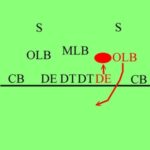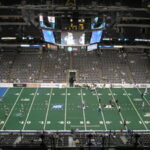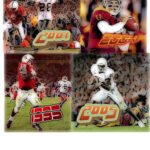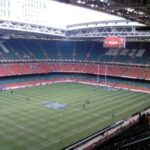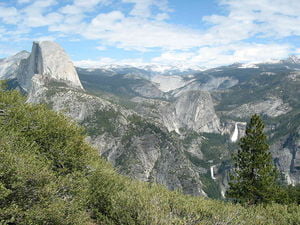OFFENSEThis is the part of your team that tries to score points on the opposing team. In a typical formation, there will be one Quarterback, two Running Backs, two Wide Receivers, a Tight End and five offensive Linemen. Some definitions:
Quarterback: The traditional team leader, he communicates the play (which are usually called by a coach) to the team in a huddle. A team mate (the ‘Center’) passes the ball to the quarterback through a “direct snap” (essentially handing the ball backwards to the quarterback) or a “shotgun snap” (whereby the quarterback may be a few yards away from the Center and the Center fires the ball backwards at him) to start each play. The Quarterback then hands off to a runner (called a Running Play) or, rarely, to a receiver. The Quarterback may also throw a forward pass to a Receiver, Running Back or Tight End.
Running Backs: In most offense groups, you have a Tailback (also known as a Halfback) and a Fullback. The Tailback is usually the faster and better runner, whereas generally speaking, the Fullback is usually the bigger, but slower, Running Back. The Fullback very seldom runs the ball – his primary job is to block for the Quarterback or Tailback. A block is when the offensive player tries to hit the defensive player and move him out of the way, or prevent him from rushing the passer.
Wide Receivers: In a basic formation, there are usually two Wide Receivers on the field. The Receiver’s job is primarily to run pass patterns and catch the ball. A pass pattern involves the WR running to a specific part of the field on the play, in an attempt to find an open space and to catch the ball. A Receiver’s secondary job is to block on running plays – although most do this half-heartedly at best.
Tight End: The TE is traditionally an extra lineman, but one that can catch passes. Most teams use them as an extra blocker and to catch passes on a limited basis. However, some Tight Ends end up with strong offense stats.
Offensive linemen: There are Right and Left tackles, usually the biggest linemen. These players stand at opposite ends of the five linemen. Their main job is to prevent pass rushers from getting around them and attempting to “sack” the Quarterback. (A sack is a successful attempt at tackling the Quarterback while he’s in play.) There are also right and left guards who play on the interior of the line. Their job is to keep the middle of the offensive line from being penetrated by defensive linemen. The Center holds the center of the field, of course, and his main job is to snap (aka hike) the ball to the quarterback to start the play. In-game, he then blocks in the middle of the offense.
DEFENSE
In a traditional 4-3 defense, there are four linemen, three linebackers and 4 defensive backs.
Defensive Linemen line up directly across from the offensive linemen on the other team. From right to left, there is a Right Defensive End, Right Defensive Tackle, Left Defensive Tackle and Left Defensive End. The Ends usually try to rush to the outside shoulder of the opposing offensive tackle. The tackles usually try to clog up the middle of the line against the guards and centers.
Linebackers: The three Linebackers line up off the line of scrimmage (where the Linemen start the play) behind the defensive line. A strong side Linebacker usually lines up on the side of the offensive formation that has the Tight End. His job is to either cover the Tight End or a Running Back on pass plays, or blitz (which rushes the passer). A middle Linebacker lines up between the two other linebackers. His job is usually to stop running plays by occupying space in the middle of the field. The third linebacker is the weak side linebacker. He lines up on the side of the formation opposite of the tight end. His job is to blitz, or cover Running Backs out of the backfield.
Defensive Backs: There are four DBs including two Cornerbacks and two Safeties The left and right Cornerbacks line up directly opposite the Wide Receivers. Their job is to cover them in pass plays, and try to prevent them from catching the ball. If the defense catches a pass, it’s called an interception – and cornerbacks tend to initiate the majority of these. The player in the Strong Safety position lines up on the side of the tight end. He often covers the Tight End or provides double cover for a Wide Receiver. The Free Safety is often a roamer – thus the name. Often this player is in deep pass coverage to prevent a long pass play. He may also move up towards the line of scrimmage to blitz or to be there to prevent a long gain on a running play.
SPECIAL TEAMS
In American Football there is a 100-yard field that is 53.3 yards wide. There are four downs/plays on offense to get a first down (which allows the team another four downs). A first down is when you have gained 10 yards in your allotted 4 downs. If you do not gain these 10 yards over the four downs, the ball is turned over to the opposing team. Which is why the offence tends to go for a field goal or punt the ball on a third down with less than 10 yards.
The Field Goal team consists of a kicker, a holder and nine linemen. The kicker tries to kick the ball through the end zone and between two crossbars to score three points – called a field goal. The crossbars are 10 yards into the end zone. In addition, if a touchdown is scored by the offence (6 points) the field goal team can attempt an extra-point kick, which is like a field goal but worth only 1 point. The defense puts a field goal block team on the field to try to block the kick. The holder on the kicking team is often a quarterback who takes a snap from center and holds the ball on the ground for the kicker to kick.
The Kickoff team also uses the kicker. After a score the offence kicks off to the defence. The ball is placed on a tee and booted by the kicker. The opposing team puts a kickoff return team on the field. This team has a kick returner who catches the kicked ball and tries to advance it. Meanwhile, the kickoff team is trying to tackle him and the rest of the kickoff return team is blocking for him.
The Punting team is used when the team doesn’t get a first down and are too far away to kick a field goal. The punter takes a long snap from center and kicks to ball to the punt return team. He does not use either a holder (player) or a kicking tee. The punt returner catches the ball and tries to advance it, like on a kickoff return.

